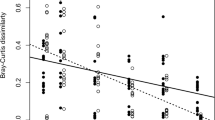Abstract
Antagonistic coevolution between hosts and parasites in spatially structured populations can result in local adaptation of parasites1,2,3,4,5; that is, the greater infectivity of local parasites than foreign parasites on local hosts1. Such parasite specialization on local hosts has implications for human health and agriculture. By contrast with classic single-species population-genetic models6,7, theory indicates that parasite migration between subpopulations might increase parasite local adaptation, as long as migration does not completely homogenize populations8,9,10,11. To test this hypothesis we developed a system-specific mathematical model and then coevolved replicate populations of the bacterium Pseudomonas fluorescens and a parasitic bacteriophage with parasite only, with host only or with no migration. Here we show that patterns of local adaptation have considerable temporal and spatial variation and that, in the absence of migration, parasites tend to be locally maladapted. However, in accord with our model, parasite migration results in parasite local adaptation, but host migration alone has no significant effect.
This is a preview of subscription content, access via your institution
Access options
Subscribe to this journal
Receive 51 print issues and online access
$199.00 per year
only $3.90 per issue
Buy this article
- Purchase on Springer Link
- Instant access to full article PDF
Prices may be subject to local taxes which are calculated during checkout




Similar content being viewed by others
References
Kawecki, T. D. & Ebert, D. Conceptual issues in local adaptation. Ecol. Lett. 7, 1225–1241 (2004)
Ebert, D. Virulence and local adaptation of a horizontally transmitted parasite. Science 265, 1084–1086 (1994)
Kaltz, O. & Shykoff, J. A. Local-adaptation in host–parasite systems. Heredity 81, 361–370 (1998)
Thompson, J. N. The evolution of species interactions. Science 284, 2116–2118 (1999)
Thompson, J. N. Specific hypotheses on the geographic mosaic of coevolution. Am. Nat. 153, S1–S14 (1999)
Slatkin, M. Gene flow and the genetic structure of natural populations. Science 236, 787–792 (1987)
Lenormand, T. Gene flow and the limits to natural selection. Trends Ecol. Evol. 17, 183–189 (2002)
Gandon, S., Capowiez, Y., Dubois, Y., Michalakis, Y. & Olivieri, I. Local adaptation and gene for gene coevolution in a metapopulation model. Proc. R. Soc. Lond. B 263, 1003–1009 (1996)
Lively, C. M. Migration, virulence and the geographic mosaic of adaptation by parasites. Am. Nat. 153, S34–S47 (1999)
Gandon, S. & Michalakis, Y. Local adaptation, evolutionary potential and host–parasite coevolution: interactions between migration, mutation, population size and generation time. J. Evol. Biol. 15, 451–462 (2002)
Gandon, S. Local adaptation and the geometry of host–parasite coevolution. Ecol. Lett. 5, 246–256 (2002)
Parker, M. A. Local population differentiation for compatability in an annual legume and its host-specific fungal pathogen. Evolution 39, 713–723 (1985)
Lively, C. M. Adaptation by a parasitic trematode to local populations of its host. Evolution 46, 1663–1671 (1989)
Lively, C. M. & Dybdahl, M. F. Parasite adaptation to locally common host genotypes. Nature 405, 679–681 (2000)
McCoy, K. D., Boulinier, T., Schjorring, S. & Michalakis, Y. Local adaptation of the ectoparasite Ixodes uriae to its seabird host. Evol. Ecol. Res. 4, 441–456 (2002)
Kaltz, O., Gandon, S., Michalakis, Y. & Shykoff, J. A. Local maladaptation in the anther-smut fungus Microbortyum violaceum to its host Silene latifolia: Evidence from a cross inoculation experiment. Evolution 53, 395–407 (1999)
Mutikainen, P., Salonen, V., Puustinen, S. & Koskela, T. Local adaptation, resistance, and virulence in a hemiparasitic plant–host plant interaction. Evolution 54, 433–440 (2000)
Oppliger, A., Vernet, R. & Baez, M. Parasite local maladaptation in the Canarian lizard Gallotia galloti (Reptilia: Lacertidae) parasitized by haemogregarian blood parasite. J. Evol. Biol. 12, 951–955 (1999)
Buckling, A. & Rainey, P. B. Antagonistic coevolution between a bacterium and a bacteriophage. Proc. R. Soc. Lond. B 269, 931–936 (2002)
Forde, S. E., Thompson, J. N. & Bohannan, B. J. M. Adaptation varies through space and time in a coevolving host–parasitoid interaction. Nature 431, 841–844 (2004)
Brockhurst, M. A., Morgan, A. D., Rainey, P. B. & Buckling, A. Population mixing accelerates coevolution. Ecol. Lett. 6, 975–979 (2003)
Lenski, R. E., Rose, M. R., Simpson, S. C. & Tadler, S. C. Long term experimental evolution in Escherichia coli. 1. Adaptation and divergence during 2000 generations. Am. Nat. 138, 1315–1341 (1991)
Agrawal, A. & Lively, C. M. Infection genetics: gene-for-gene versus matching-alleles models and all points in between. Evol. Ecol. Res. 4, 79–90 (2002)
Frank, S. A. Statistical properties of polymorphism in host–parasite genetics. Evol. Ecol. 10, 307–317 (1996)
Morand, S., Manning, S. D. & Woolhouse, M. E. J. Parasite–host coevolution and geographic patterns of parasite infectivity and host susceptibility. Proc. R. Soc. Lond. B 263, 119–128 (1996)
Crawley, M. J. GLIM for Ecologists (Blackwell Science, Oxford, 1993)
Lenski, R. E. Coevolution of bacteria and phage—are there endless cycles of bacterial defenses and phage counterdefenses? J. Theor. Biol. 108, 319–325 (1984)
Miralles, R., Moya, A. & Elena, S. F. Effect of poulation patchiness and migration rates on the adaptation and divergence of vesicular stomatitis virus quasispecies populations. J. Gen. Virol. 80, 2051–2059 (1999)
Rainey, P. B. & Bailey, M. J. Physical and genetic map of the Pseudomonas fluorescens SBW25 chromosome. Mol. Microbiol. 19, 521–533 (1996)
Acknowledgements
We thank M. Brockhurst, T. Day, F. Harrison, O. Kaltz, C. Lively and his group, Y. Michalakis, I. Olivieri, L. Lopez Pascua and A. Rivero for comments on the manuscript. This work was funded by the Royal Society.
Author information
Authors and Affiliations
Corresponding author
Ethics declarations
Competing interests
Reprints and permissions information is available at npg.nature.com/reprintsandpermissions. The authors declare no competing financial interests.
Supplementary information
Supplementary Notes
The Supplementary Notes contains a discussion of different measures of local adaptation (including Fig. S1) and details of the model formulation and results (including a table and Fig. S2). (DOC 268 kb)
Rights and permissions
About this article
Cite this article
Morgan, A., Gandon, S. & Buckling, A. The effect of migration on local adaptation in a coevolving host–parasite system. Nature 437, 253–256 (2005). https://doi.org/10.1038/nature03913
Received:
Accepted:
Issue Date:
DOI: https://doi.org/10.1038/nature03913
This article is cited by
-
Spatial patterns in phage-Rhizobium coevolutionary interactions across regions of common bean domestication
The ISME Journal (2021)
-
Host–parasite co-evolution and its genomic signature
Nature Reviews Genetics (2020)
-
Relationships of virus titers and transmission rates among sympatric and allopatric virus isolates and thrips vectors support local adaptation
Scientific Reports (2020)
-
Gene flow and adaptive potential in a generalist ectoparasite
BMC Evolutionary Biology (2018)
-
Bottom-up and top-down control of dispersal across major organismal groups
Nature Ecology & Evolution (2018)
Comments
By submitting a comment you agree to abide by our Terms and Community Guidelines. If you find something abusive or that does not comply with our terms or guidelines please flag it as inappropriate.



